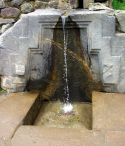Chakana Cross
The image on the left could be seen as a cross with pointed bits between the arms, or a square with rectangular bits on the side, or a white circle with a jagged border. Yet it's supposed to be none of those things.
There is neither a 'cross' nor a 'square', but four symmetrical triple steps.
And it's not a white circle; it's a hole.
The Chakana Cross is also known as the Andean Cross or Inca Cross, and symbolizes several aspects of Andean mythology.
Three Steps

Baños de la Ñusta (Bath of the princess), at the base of the ruins in Ollantaytambo, 60km NW of Cusco
Photo by 'Stevage'. Click photo to enlarge
The three steps represent levels of attainment of consciousness in the three 'worlds' or tiers:
- Hanan Pacha: the upper world of the stars, celestial beings and gods (also represented by the condor)
- Kay Pacha: the middle world of Mother Earth and human life (also represented by the puma)
- Uqhu Pacha: the lower world of the underworld and death (also represented by the snake)
Central hole
The central hole represents the Incan capital of Cusco, the portal from one tier to the next, and the Eye of God.
Twelve points
The entire symbol additionally represents the cyclical year, with each of the twelve corners corresponding to a month.
Four arms
The four 'cross' arms represent:
- the four directions of the compass,
- the four 'classical elements' of earth, air, water and fire,
- the four main stars of the Southern Cross, an important constellation for the Inca, who believed that was the centre of the Universe.
Sacred Geometry
More recently, the Chakana Cross has taken on more esoteric and astrological symbolism. To some Neopagans, the Chakana Cross itself is believed to have power if constructed to a very precise and sacred geometric formula. This interest has blossomed in line with the increased number of tourists from Europe and North America.
In our diagram shown on the right, the red diagonal (southwest / northeast) line represents the earth's axial tilt, currently around 23.44°. This determines the breadth of the top and bottom horizontal blue lines, which in turn dictate all the other measurements. The Inca are believed to have used this as a measuring tool for determining changes in the sun's path over the course of a year and from that, predict the growing cycles.
Comparison with the Christian Cross
The Christian Cross may feature numbers such as three (Trinity), four (Evangelists), twelve (Apostles) and the circle (Celtic, Halo, Glory, etc.) but it doesn't claim any of the advantages of the Chakana Cross with its use as an almanac, meditational aid for transcending cosmic tiers, and so on.
Instead, the Christian Cross points to a single and very simple message. See the meaning of the Cross.
"Chakana" is derived from chakay ("to cross") in the Inca language of Quechua
See also Cardinal Cross
There are inconsistencies amongst devotees in determining which of the precise measurements are correct

